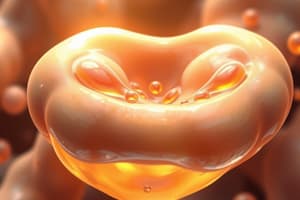Podcast
Questions and Answers
What is the primary role of lipids in biological systems?
What is the primary role of lipids in biological systems?
- Transport of nutrients in the bloodstream
- Synthesis of proteins
- DNA replication and repair
- Energy storage and cellular signaling (correct)
What factors contribute to the spontaneous formation of the cell membrane?
What factors contribute to the spontaneous formation of the cell membrane?
- A decrease in ΔG and an increase in ΔS (correct)
- An increase in ΔG and an increase in ΔS
- A decrease in ΔG and a decrease in ΔS
- A constant ΔG and a variable ΔS
Which of the following statements about phospholipids is correct?
Which of the following statements about phospholipids is correct?
- They are hydrophobic and do not form bilayers.
- They are primarily used for energy storage.
- They act as signaling molecules only.
- They contribute to the structural integrity of cell membranes. (correct)
What is the significance of hydrogen bonds in DNA?
What is the significance of hydrogen bonds in DNA?
What does ΔS represent in the context of spontaneous processes?
What does ΔS represent in the context of spontaneous processes?
Flashcards are hidden until you start studying
Study Notes
Introduction to Bioengineering: Lipids and Cell Membrane Formation
- Lipids are composed of fatty acid monomers, crucial for energy storage, maintaining cellular structure, and signaling processes.
- Phospholipids play a critical role in forming the structure of cell membranes.
Types of Unsaturated Fatty Acids
- Unsaturated fatty acids are a category of lipids characterized by one or more double bonds in their hydrocarbon chains, influencing their physical properties and biological functions.
Miscellaneous Lipid Functions
- Other types of lipids serve various roles, including signaling and forming cellular compartments.
Cell Membrane Formation
- Cell membranes are formed through a bilayer created by the self-assembly of lipid molecules.
- A negative change in Gibbs Free Energy (ΔG) indicates a spontaneous process; for ΔG to be negative, entropy (ΔS) needs to increase, reflecting increased randomness in the system.
DNA as Hereditary Material
- DNA, composed of nucleotides, serves as the hereditary material.
- Each nucleotide comprises a nitrogenous base (like Adenine), a phosphate group, and a sugar (2-deoxy ribose).
DNA Structure and Hydrogen Bonds
- The structure of DNA is stabilized by hydrogen bonds between complementary bases, ensuring the integrity of genetic information.
Studying That Suits You
Use AI to generate personalized quizzes and flashcards to suit your learning preferences.




